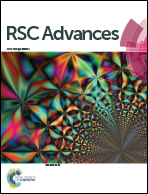Near-infrared polyfluorene encapsulated in poly(ε-caprolactone) nanoparticles with remarkable large Stokes shift†
Abstract
Near-infrared (NIR) fluorescent dyes have attracted increasing attention as fluorescent probes in biomedical applications due to their low biological autofluorescence as well as high tissue penetration depth. However, their being hydrophobic in nature limits their clinical use as they are prone to aggregate in the physiological environment. Herein, we have designed and synthesized a novel polymeric NIR fluorescent dye and then encapsulated it into a poly(ε-caprolactone) (PCL) matrix by way of an emulsion–diffusion technique. The effect of the structure of the surfactant on the nanoparticle properties is investigated. Results show that polymeric surfactant, Kolliphor® P188, allows the formation of a high fluorescence intensity of the nanoparticles with the highest level homogeneity and stability. The synthesized nanoparticles show significant advantages in terms of a remarkable large stokes shift (276 nm) in the aqueous solution and excellent biocompatibility. The fabrication process is not limited to encapsulation of polymeric fluorescent dye. The synthesized NIR polymeric nanoparticles would be potentially applicable for biomedical applications.



 Please wait while we load your content...
Please wait while we load your content...